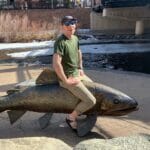“Let’s go catch some goldfish.”
This is not the phrase an Alaskan angler, or likely any angler, anticipates hearing. However, this summer it was brought to Anchorage residents’ attention that goldfish have been gleefully parading around an urban pond in colorful schools for some time.
With plans to eradicate the invasive species, and orders to catch and kill handed down from the Alaska Department of Fish & Game, it was officially open season on the seemingly innocent, domesticated species. Moreover, the presence of a foreign, finned species represented a fresh opportunity to put the ole noodles (brain and fly rod) to the test.
My wife and I hit the Kentucky bluegrass, draped blade to blade in goose droppings, surrounding the pond with an hour to fish before work. Let’s just say, this pond is the epitome of urban.
The golden invaders stuck out like a Cheeto dusted thumb and Brittney and I were quickly targeting schools of, by our standards, trophy class goldfish working their way in and out of the thick aquatic vegetation.
Unsure what comprises a goldfish’s palette, and having completed only limited research ahead of time, the diverse selection of patterns in our fly boxes were used to the fullest. Unsurprisingly, a miniature egg sucking leach pattern, a favorite fly of most any species, quickly picked up some lazily trailing fish until it found one with enough pizzazz to take a bite out of it.
I’d be lying if I eluded to the fish putting up any sort of a fight, but still I was celebrating. It’s not much of an accolade, but I’m one of the few that have caught goldfish on the fly.
Alaska is generally recognized for its flourishing wild and native species and pristine habitat, but several invasive species have firmly planted their roots into foreign waters with little willingness to budge.
Fortunately, in this scenario, goldfish aren’t an apex predator, or really all that threatening at all, and the pond they were introduced to is mostly an isolated body of water that already has its own share of ecological issues. It is far from the pristine waters most people associate with Alaska. Though, in just a small amount of time, the invasive goldfish made themselves at home and had reproduced with a population in the thousands.
Ultimately the Alaska Department of Fish & Game had to poison the pond with rotenone, a short lived, plant-based pesticide routinely used to kill invasive fish.
The introduction of a foreign fish to lakes in the Anchorage area is not an isolated incident. Many have been successfully treated to eradicate northern pike and just last year a local angler was shocked to find a bass on the end of their line.
Beyond Anchorage, many lakes are being taken over with growing populations of invasive northern pike that are causing severe impacts to native trout and salmon in several lakes and rivers, and elodea, an invasive aquatic plant, is spreading like wildfire and choking out lakes.
Alaska’s issues with aquatic invasive species pale in comparison to the struggles of other areas in the United States and world, but they are recent enough, and in many cases minimal enough, to serve as a reminder of what we are fortunate to have, and how quickly we can lose it.
One greedy, un-educated, or simply convenient, decision can disrupt a fragile ecosystem at the expense of native species and immense state funds for eradication.
These are your waters and their health rides on your shoulders; the best way to stop the spread of invasive aquatic species is to not introduce them in the first place.
Eric Booton is the sportsmen’s outreach coordinator for TU’s Alaska Program. He lives and works in Anchorage.



